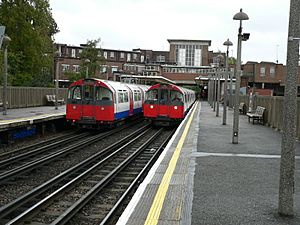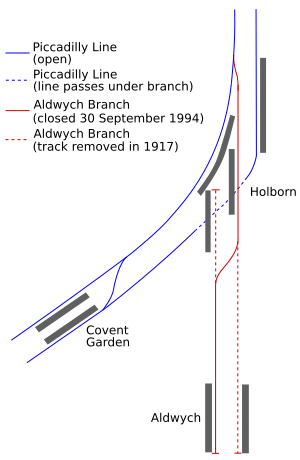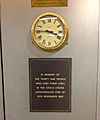Piccadilly line facts for kids
| Colour on map | Dark blue |
| Year opened | 1906 |
| Line type | Deep Tube |
| Rolling stock | 1973 tube stock 6 cars per trainset |
| Stations served | 53 |
| Length | 71 km (44 mi) |
| Depots | Cockfosters Northfields |
| Journeys made | 176,177,000 |
The Piccadilly line is a very important part of the London Underground train system. It's easy to spot on the Tube map because it's coloured a deep, dark blue. This line is one of the busiest, carrying millions of passengers every year! It mostly runs deep underground, travelling from the north of London all the way to the west. But don't worry, some parts of the line are above ground, especially towards the west. Out of its 53 stations, 25 are underground. It's also the second longest line in the whole London Underground system, right after the Central line.
Contents
How the Piccadilly Line Works
The Trains: Rolling Stock
The Piccadilly line uses special trains called the 1973 tube stock. These trains are painted in the classic London Underground colours: blue, white, and red. To keep the line running smoothly during busy times, 76 of these trains are needed.
One of these trains was badly damaged in a sad event on 7 July 2005. The trains were recently updated, but plans to replace them with brand new ones were cancelled in 2010.
Before the 1973 stock, the line used older types of trains like the 1959, 1956, 1938, and 1906 tube stock.
The Piccadilly line has two main train storage and maintenance areas, called depots. These are located at Northfields and Cockfosters. There are also smaller storage tracks, called sidings, at places like Oakwood, South Harrow, and Uxbridge.
How Trains are Controlled: Signalling
The trains on the Piccadilly line are controlled from a special centre at Earl's Court. This centre makes sure trains run safely and on time. The system needs to be updated, but plans for this work were also cancelled.
Train Routes: Service Pattern
During quieter times of the day, trains follow a few main routes:
- 6 trains per hour go from Cockfosters to Heathrow Terminal 5.
- 6 trains per hour go from Cockfosters to Heathrow Terminal 4. These trains go around a loop and also stop at Terminals 1, 2, and 3.
- 3 trains per hour go from Cockfosters to Uxbridge.
- 3 trains per hour go from Cockfosters to Rayners Lane.
- 6 trains per hour go from Arnos Grove to Northfields.
Sometimes, late in the evening, trains might end their journey at Oakwood instead of Cockfosters. Also, trains stop at Turnham Green in the early mornings and late evenings, but not during the main part of the day.
Stations That Are No Longer Open
Over the years, some stations on or near the Piccadilly line have closed. Here are a few:
- Aldwych opened in 1907 as Strand tube station. It was at the end of a short branch line from Holborn. It was mainly used for a shuttle service from Holborn. During World War II, it was used as an air-raid shelter. It closed for good in 1994 because not enough people used it, and it would have cost too much to fix the lifts. This station is now often used for filming movies and TV shows!
- Brompton Road opened in 1906 and closed in 1934. It was located between Knightsbridge and South Kensington.
- Down Street opened in 1906 and closed in 1932. It was between Green Park and Hyde Park Corner.
- Osterley & Spring Grove was served by trains from 1933 to 1934. It was replaced by the current Osterley station.
- Park Royal & Twyford Abbey opened in 1903 but closed in 1931. Even though it was on the route of the Piccadilly line, Piccadilly trains never actually stopped there. It was originally used by the District line and was replaced by the current Park Royal station before the Piccadilly line started running trains to that area.
- York Road opened in 1906 and closed in 1932. It was between King's Cross St Pancras and Caledonian Road. There have been talks about reopening it because of new buildings nearby, but this isn't happening right now.
The Future of the Piccadilly Line
There were big plans to upgrade the Piccadilly line around 2014-2015. This would have included new trains and a new signalling system, which would have allowed the line to carry about 24% more passengers. However, these plans were cancelled in 2010.
Images for kids
-
Lots Road Power Station, disused and planned to be redeveloped
See also
 In Spanish: Piccadilly Line para niños
In Spanish: Piccadilly Line para niños









